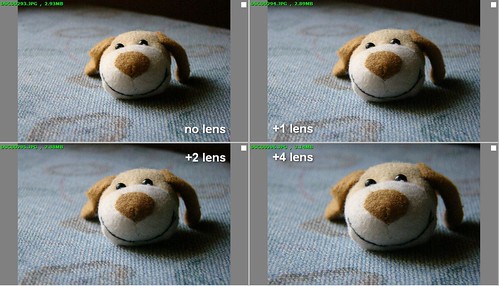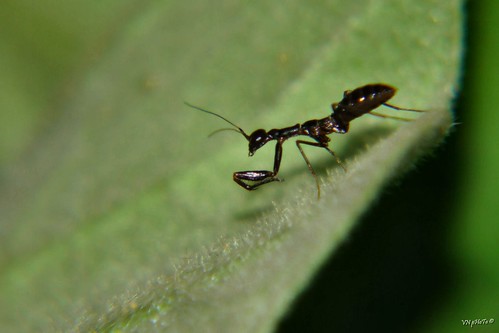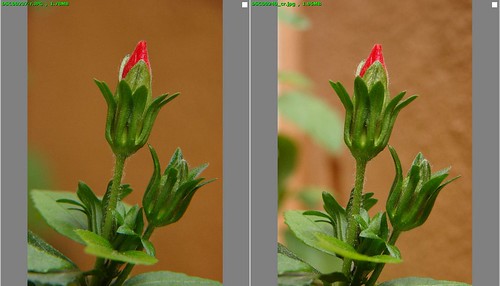Disclaimer: This article is not a recommendation for the brand of close up lens discussed here. I may not be always right of what is stated here. I am sharing my honest opinion having used this lens kit.
.
I'm gonna talk about the close up lens kit from Zeikos. It retails for about $25 US and I sourced mine from eBay. This one here is with72mm thread. I use it on Sony DSC-H50 (with a 74mm to 72mm step down ring attached)
I wasn't sure about the quality (optics) of this brand (Zeikos) and could not find any useful reviews about it over the web and So I risked to give it a try and here is what I have to share about this close-up lens kit.
 |
| photo of the 72mm closeup lens kit |
The close-up kit is sold as 4 lens kit (+1 +2 +4 & +10) and 5 lens kit (+1 +2 +4 +8 & +10) and comes with a neat carrying case. I decided to buy the kit with 4 lens (assuming 1 less lens to carry ) and that you can stack these lens to add up the diopters (1+2+4 stack = +7 diopter). Lets talk about stacking these lenses as we go into the review.
These close-up lenses are all single element glass and they dont have any coatings as such. so they are plain optical glass mounted on black metal ring. they are double threaded so you can stack the +1 +2 and +4 to get additional magnification or even attach other filters like polarizers.
Combining the lens will add the magnification, a +1 stacked to a +4 lens gives you total magnification of +5.
A stack of +2 and +4 will give you +6. the higher the number the heavier the lens. the +10 lens is heaviest of the lot.
When stacking, always put the lower diopter lens first, for eg if you are stacking +2 with +4 lens put the +2 on the camera side thread first and then attach the +4 to the +2 lens thread. Stacking lens adds more glass between the subject and the camera lens which might degrade image quality. so its upto you to decide to stack or not. I dont stack lenses and dont see the neccessity to do so.
The +10 lens is pretty much useless due to its optical limitation; the depth of field is so shallow you cant really put anything in there to focus. theres a lot of image distortion and chromatic aberration making this hulk a complete waste.
Although I was impressed with the results the +1 +2 & +4 produced. it works throughout the zoom range of my Sony H50 and hardly any noticeble distortion in the image. Ofcourse there is chromatic aberration where you have high contrast situations. But can be avoided or minimised if you work within the limitation of these lens or any lens for that matter. Choose or place your subject in a non-contrasty situation in the first place.
A comparision of the +1 +2 and +4 lens magnification. the camera was mounted on a tripod. the subject to camera distance was maintained while changing only the close-up lens.

Some sample images using the +4 lens. I find myself using the +4 very often to get close to the subject.
This ant was sitting quite and steady on a brinjal leaf. the ant is just under a centimeter in length
 |
| Sample 1. Shot with Sony DSC-H50 at 78mm (@ 15X zoom) with the +4 close up lens f8, 1/200 shutter, flash ON. subject distance ~10 inch |
 |
| Sample 2. shot with Sony DSC-H50 at 27mm (@ 5X zoom) with +4 close-up lens f5, 1/250 shutter, subject distance ~8 inch |
Besides magnifying your subject close-up lenses are capable of producing nice quality blur (bokeh) which otherwise wouldnt be possible with the proprietory lens on your point & shoot camera.
this effect can be utilised for portraits where the blurred out background is much sought after.
A sample photo showing blurred out background.
 |
| with close-up lens without close-up lens |
CLOSE-UP lens Basics
They are called differently by different people. if you hear things like close up filters, close up lens, diopter lens they are all the same. you will see the word macro lens being used. I will stick with the use of "close-up lens" for the rest of this article.
Why use close up lenses? simply to achieve magnification. whats a zoom then? you might ask.
let me put it in simple words.
x ZOOM lets you bring the subject close to you. you need a zoom lens to do this which we are familiar with. eg with 3x zoom. you bring the subject 3 times closer to you.
+ CLOSE-UP lets you magnify the subject. its just like how the microscope works. and the strength of the magnification is termed diopter, the number on the close up lens. eg +1 +2 +4.
+4 magnifies more than the +2 would. there is something known as working distance that you need to figure out. this might vary with different lens (or camera). But in general, higher the magnification (eg +4) smaller the working distance. the working distance of a +2 will be twice that of the +4, meaning you can stay away from your subject. its a trade off between distance and magnification which you need to make given your shooting conditions.
The close up lens essentially reduces the subject to image sensor distance (focal length) which allows for magnification. you can zoom in all the way and still focus on close by subject.
To use the close-up lens, start with say +4 lens, attach it to your camera, set the focus mode to infinity, zoom in fully, pick a subject that wont move, get close (more likely) or away from your subject untill you see your subject in focus. buy now you would have figured out that using close-up lens gives you only a shallow depth of field where your subject is in focus and that is the working distance for the +4 lens. similarly you can figure out working distance for the other diopters.
Update: 10 NOV 2010
----
I mentioned about setting the focus at infinity, doing this will allow you more working distance to your subject which means you will move away from your subject a bit and hence a bit smaller image size. the idea of setting focus at infinity is to get rid of focus hunting while using auto-focus. I have noticed using autofocus reduces your working distance a bit (allows you to close in more on your subject!) but will take some time to acheive focus (there will be focus hunting more likely if your working distance in not optimal).
----
Using closeup lens is a lot of pain and time consuming. The challenge is to acheive focus.
At full zoom, even with image stabilization ON, small hand movement can change your focus and pose a great risk to your compostion. you may total miss out your subject on the lcd screen! so a tripod is necessary (flexible tripods are helpful where you have your subject close to the ground )
You need to experiment on the lighting needs and more importantly choosing your subject.
Closeup photogaphy is all about getting the most of your subject in focus.
Good luck!
No comments:
Post a Comment